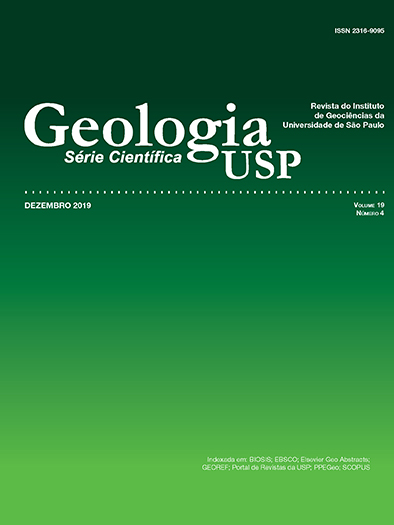Geology, structural control and mineralogy of gold and tungsten mineralized skarn at Bonfim Mine, Borborema Province, Rio Grande do Norte, Brazil.
DOI:
https://doi.org/10.11606/issn.2316-9095.v19-151883Keywords:
Skarn, Bonfim, Scheelite, Gold, Fractures, PrehniteAbstract
The Bonfim Mine is characterized by marbles layers in contact with underlying phlogopite schists, along which gold- and tungsten-rich skarns were developed, in N10ºE/30ºSE direction, sheared and structured as boudins plunging 12º to N10ºE. Scheelite is found in the boudins, associated to molybdenite, both being formed under ductile syntectonic conditions, consisting of the first phase of mineralization. Gold is found in late shear fractures, oriented N70ºW/75ºSW, that cut and displace the scheelitiferous skarn. The fractures are filled by prehnite (gangue), gold and bismuth minerals, indicating that gold precipitation occurred in the prehnite-pumpelliyte facies under ductile-brittle regime, which corresponds to the 2nd phase of mineralization. The gold is rich in silver with up to 16.09%Ag and its occurrences are: free in gangue, in fractures and in contact with bismuth, bismuthinite and joséite, constituting auriferous paragenesis. Gold grains show bismuth in its microprobe analyses composition, reaching up to 0.44%Bi. The ore is hosted in a reduced skarn, generated in
progressive and retrogressive stages, the product of metasomatism in marbles altered by fluids carried along the structures.
Downloads
Downloads
Published
Issue
Section
License
Authors who publish in this journal shall comply with the following terms:
- Authors keep their copyright and grant to Geologia USP: Série Científica the right of first publication, with the paper under the Creative Commons BY-NC-SA license (summary of the license: https://creativecommons.org/licenses/by-nc-sa/4.0 | full text of the license: https://creativecommons.org/licenses/by-nc-sa/4.0/legalcode) that allows the non-commercial sharing of the paper and granting the proper copyrights of the first publication in this journal.
- Authors are authorized to take additional contracts separately, for non-exclusive distribution of the version of the paper published in this journal (publish in institutional repository or as a book chapter), granting the proper copyrights of first publication in this journal.
- Authors are allowed and encouraged to publish and distribute their paper online (in institutional repositories or their personal page) at any point before or during the editorial process, since this can generate productive changes as well as increase the impact and citation of the published paper (See The effect of Open Access and downloads on citation impact).





